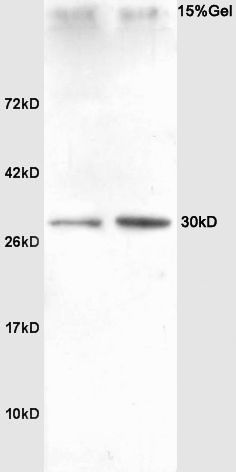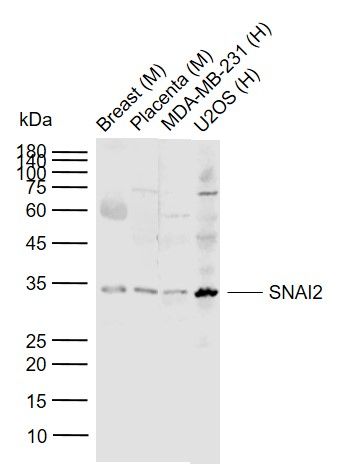BMPs (bone morphogenetic proteins) belong to the TGF beta superfamily of structurally related signaling proteins. Members of this superfamily are widely represented throughout the animal kingdom and have been implicated in a variety of developmental processes. Proteins of the TGF beta superfamily are disulfide-linked dimers composed of two 12-15 kDa polypeptide chains. As implied by their name, BMPs initiate, promote and regulate bone development, growth, remodeling and repair. Smad1 translocation to the nucleus is observed after the addition of BMP4 (also designated BMP2B), suggesting that BMP4 may play a role in activation of the Smad pathway. BMP is secreted into the extracellular matrix.
Function:
Induces cartilage and bone formation. Also act in mesoderm induction, tooth development, limb formation and fracture repair. Acts in concert with PTHLH/PTHRP to stimulate ductal outgrowth during embryonic mammary development and to inhibit hair follicle induction.
Subunit:
Homodimer; disulfide-linked. Interacts with GREM2. Part of a complex consisting of TWSG1 and CHRD. Interacts with the serine proteases, HTRA1 and HTRA3; the interaction with either inhibits BMP4-mediated signaling. The HTRA protease activity is required for this inhibition. Interacts with SOSTDC1.
Subcellular Location:
Secreted, extracellular space, extracellular matrix.
Tissue Specificity:
Expressed in the lung and lower levels seen in the kidney. Present also in normal and neoplastic prostate tissues, and prostate cancer cell lines.
DISEASE:
Microphthalmia, syndromic, 6 (MCOPS6) [MIM:607932]: A disease characterized by microphthalmia/anophthalmia associated with facial, genital, skeletal, neurologic and endocrine anomalies. Microphthalmia is a disorder of eye formation, ranging from small size of a single eye to complete bilateral absence of ocular tissues (anophthalmia). In many cases, microphthalmia/anophthalmia occurs in association with syndromes that include non-ocular abnormalities. Note=The disease is caused by mutations affecting the gene represented in this entry.
Non-syndromic orofacial cleft 11 (OFC11) [MIM:600625]: A birth defect consisting of cleft lips with or without cleft palate. Cleft lips are associated with cleft palate in two-third of cases. A cleft lip can occur on one or both sides and range in severity from a simple notch in the upper lip to a complete opening in the lip extending into the floor of the nostril and involving the upper gum. Note=The disease is caused by mutations affecting the gene represented in this entry.
Similarity:
Belongs to the TGF-beta family.
SWISS:
P12644
Gene ID:
652
Database links:
Entrez Gene: 407216 Cow
Entrez Gene: 652 Human
Entrez Gene: 12159 Mouse
Entrez Gene: 100113425 Pig
Entrez Gene: 25296 Rat
Omim: 112262 Human
SwissProt: Q2KJH1 Cow
SwissProt: P12644 Human
SwissProt: P21275 Mouse
SwissProt: Q06826 Rat
Unigene: 68879 Human
Unigene: 6813 Mouse
Unigene: 10318 Rat
骨形态发生蛋白-4(BMP4)是转化生长因子β超家族成员,也参与器官发生,细胞增殖、分化及凋亡等。
| Picture |
Sample:
Sheep skin (Sheep) Lysate at 40 ug
Primary: Anti-BMP4 (SL1374R) at 1/300 dilution
Secondary: IRDye800CW Goat Anti-Rabbit IgG at 1/20000 dilution
Predicted band size: 13/45 kD
Observed band size: 50 kD
Paraformaldehyde-fixed, paraffin embedded (mouse pancreas tissue); Antigen retrieval by boiling in sodium citrate buffer (pH6.0) for 15min; Block endogenous peroxidase by 3% hydrogen peroxide for 20 minutes; Blocking buffer (normal goat serum) at 37°C for 30min; Antibody incubation with (BMP4) Polyclonal Antibody, Unconjugated (SL1374R) at 1:400 overnight at 4°C, followed by a conjugated secondary (sp-0023) for 20 minutes and DAB staining.
|
|
|

